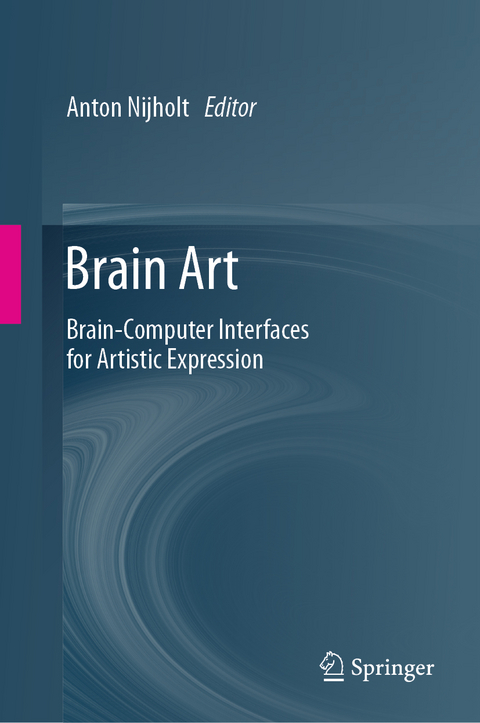
Brain Art
Springer International Publishing (Verlag)
978-3-030-14322-0 (ISBN)
This is the first book on brain-computer interfaces (BCI) that aims to explain how these BCI interfaces can be used for artistic goals. Devices that measure changes in brain activity in various regions of our brain are available and they make it possible to investigate how brain activity is related to experiencing and creating art. Brain activity can also be monitored in order to find out about the affective state of a performer or bystander and use this knowledge to create or adapt an interactive multi-sensorial (audio, visual, tactile) piece of art. Making use of the measured affective state is just one of the possible ways to use BCI for artistic expression.
We can also stimulate brain activity. It can be evoked externally by exposing our brain to external events, whether they are visual, auditory, or tactile. Knowing about the stimuli and the effect on the brain makes it possible to translate such external stimuli to decisions and commands that help to design, implement, or adapt an artistic performance, or interactive installation. Stimulating brain activity can also be done internally. Brain activity can be voluntarily manipulated and changes can be translated into computer commands to realize an artistic vision.
The chapters in this book have been written by researchers in human-computer interaction, brain-computer interaction, neuroscience, psychology and social sciences, often in cooperation with artists using BCI in their work. It is the perfect book for those seeking to learn about brain-computer interfaces used for artistic applications.
Anton Nijholt studied mathematics and computer science at the Technical University of Delft, the Netherlands and received a Ph.D. degree in theoretical computer science from the Vrije Universiteit, Amsterdam, The Netherlands, in 1980. He is a Professor of Computer Science in the Human Media Interaction group, University of Twente, Enschede, The Netherlands. He held positions at various universities in and outside The Netherlands. His main research interests are entertainment computing, multimodal interaction, affective computing, and brain-computer interfacing. He has hundreds of scientific publications, including (edited) books on the history of computing, language processing, and brain-computer interfacing. Recently he edited the books: "Playful User Interfaces", "More Playful User Interfaces", "Entertaining the Whole World", and "Playable Cities", all with Springer. He has been a guest-editor for Journal on Multimodal User Interfaces, International Journal of Arts and Technology, Entertainment Computing, International Journal of Creative Interfaces and Computer Graphics (IJCICG) and the Brain-Computer Interfaces journal. Together with Chang S. Nam and Fabien Lotte he was editor of the "Brain-Computer Interfaces Handbook: Technological and Theoretical Advances" (Taylor & Francis, 2018). Professor Nijholt is also Specialty Chief Editor of Frontiers in Human-Media Interaction and (associate) editor of several other journals. He has also served as Program Chair and General Chair for the main international conferences on affective computing, multimodal interaction, virtual agents, and entertainment computing.
Introduction: Brain-computer interfaces for artistic expression.- A state of the art and taxonomy of contemporary artworks that employ EEG-based brain-computer interfaces.- Understanding perceptual experience of art using Mobile Brain/Body imaging.- The making of Brain Painting - from the idea to daily life use by people in the locked-in state.- The interface is the work: EEG-feedback, arts and the rise of real-time brainmedia (1964-1977).- Using synchrony-based neurofeedback art in search of human connectedness.- EEG KISS: shared multi brain, multi modal, BCI experience.- New ways of knowing ourselves. BCI facilitating artistic exploration of our biology.- The BR4IN.IO hackathons.- BCI-Based Expressive Arts: Moving Toward Mind-Body Alignment.- Understanding the Neural Basis of Artistic Expression through Mobile Brain-Body Imaging.- Evaluating BCI for musical expression: historical approaches, challenges and solutions.- Methods and Tools for using BCI with Augmented and Virtual Reality.- Brain Controlled Cinema.- Self-Consciousness and Physical Memory: An immersive, kinetic art installation driven by real-time and archival EEG signals.
"For the first time, readers can learn about the enormous scope of BCI experimentation in art and art-related projects, dating back many decades, all in one volume. Importantly, this book is not only for people with an interest in the arts, but is also of high importance to the wider BCI scientific and engineering community." (Doron Friedman, Brain Computer Interfaces, April 24, 2020)
"It provides a comprehensive picture of aesthetic concerns and technological advances that have shaped interaction with brain-computer interfaces (BCI). The edited volume also includes thorough documentation of recent artworks, experiments, and therapies based on neurofeedback. It can constitute an essential resource for historians and media theorists examining the development of this genre. ... Nijholt's book aptly extends the scope of aesthetic expression beyond the realm of fine art and music." (Cristina Albu, Leonardo, October, 2019)
| Erscheinungsdatum | 06.06.2019 |
|---|---|
| Zusatzinfo | XII, 473 p. 373 illus., 162 illus. in color. |
| Verlagsort | Cham |
| Sprache | englisch |
| Maße | 155 x 235 mm |
| Gewicht | 889 g |
| Themenwelt | Mathematik / Informatik ► Informatik ► Betriebssysteme / Server |
| Informatik ► Software Entwicklung ► User Interfaces (HCI) | |
| Schlagworte | Artistic Brain-Computer Interfaces • Audio-visual Landscapes • Brain-computer interfaces • Multi-party and Hybrid Brain-computer Interfaces • Passive Brain-Computer Interfacing |
| ISBN-10 | 3-030-14322-8 / 3030143228 |
| ISBN-13 | 978-3-030-14322-0 / 9783030143220 |
| Zustand | Neuware |
| Haben Sie eine Frage zum Produkt? |
aus dem Bereich


